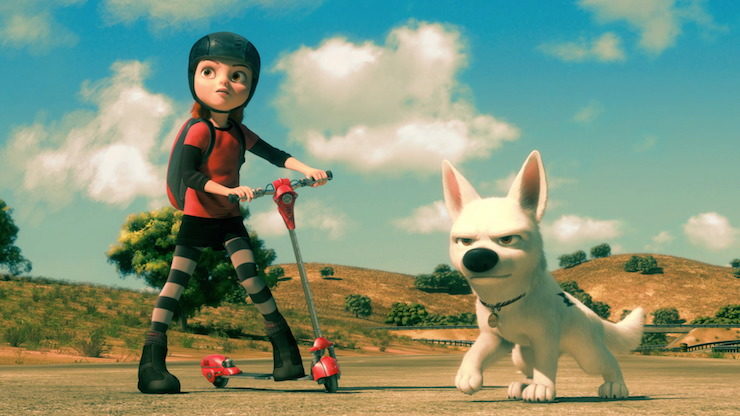After his appointment as Disney’s new Chief Creative Officer in 2006, John Lasseter’s first task was to look at what projects the animation department had on hand. Some, like Meet the Robinsons, were immediately put through a rapid revamping process in a desperate effort to get a decent film out in time to meet various cross promotional contracted deadlines. Some, like The Princess and the Frog, were rapidly moved from a Disney Princess marketing concept into full production. Some, including sequels to Chicken Little and The Aristocats, were simply cancelled.
That left a few oddball projects, like the one about a TV reality star stranded in the Arizona desert, with two twists: the TV star was an adorable dog, and one of his companions was a radioactive rabbit. Chris Sanders, who was spearheading the film, had been responsible for Lilo & Stitch, one of Disney’s few bright box office moments from the previous decade. With a radioactive rabbit as a major character, the tentatively titled American Dog promised to offer some of the same wacky zaniness and hijinks, plus a cute puppy. It would also be Disney’s third full length attempt at computer animation, with animators working fiercely to combat some of the technical and artistic issues of the earlier two computer animated films.
The key word in the above paragraph: promised. Lasseter, after viewing the completed animation, felt that the film promised more than it delivered, and requested—or demanded, depending upon who’s telling the story—changes. Sanders listened to the proposed changes, and instead of making any of them, headed over to rival Dreamworks. A few years later he was happily producing How to Train Your Dragon for Dreamworks while still continuing to voice Stitch on various Disney projects.
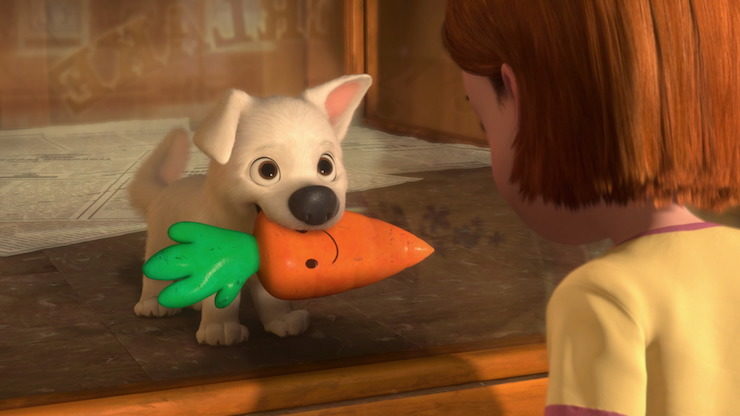
In the meantime, Disney was left scrambling to find someone else to direct the film. Lasseter pulled in Chris Williams, who had helped transform Kingdom of the Sun from development hell into The Emperor’s New Groove, and animator Bryon Howard, who had been working as an animation supervisor, giving them 18 months to complete a computer animated film—a process that, as animators helpfully explained later, usually takes four years.
The time constraints meant that although the animators could and did throw out the idea of the radioactive rabbit (talk about missed opportunities, sigh), they were stuck with many of the other film concepts, most notably, the conceit that the protagonist dog was a TV star. But the time constraints didn’t prevent the animators from creating some beautiful moments.
For instance, the film’s opening shot: a shop window animated so precisely that for one second, it looks like live footage, right before it shimmers and shifts into a non-photorealistic rendering of a pet shop. It was the sort of casual camera trick that Disney animators had avoided for several years, but it works beautifully here as the first shot of a film exploring the differences between television and reality.
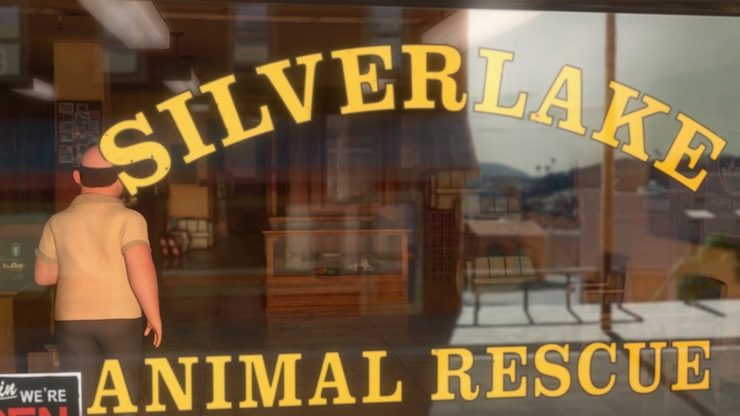
Little puppy Bolt, I must say, is not at all interested in these sorts of deep philosophical issues, or even his fellow puppies. He wants to chew on a squeak toy shaped like a carrot. Small girl Penny finds his antics hilarious, and immediately wants him for her very own puppy. It all ends with puppy and girl exchanging delighted hugs and becoming Best Friends Forever.
Cut to a few years later, and the sight of Penny and Bolt desperately running away from an army of evil robots before launching into a high speed car and scooter chase, complete with… dangling sound mikes. The sight of the mikes drives another character into a frenzy. No, not Penny, or the dog, or even the robots, but the director.
Because, as it turns out, none of this is real—it’s just a TV show, and the director is absolutely, positively 100% certain that the show can only work if the dog believes that everything he sees is real, and never even guesses that he’s just part of a television show. If the dog ever figures out the truth—well, the show is over, because the dog won’t be able to give a decent performance, and –
No.
Just, no.
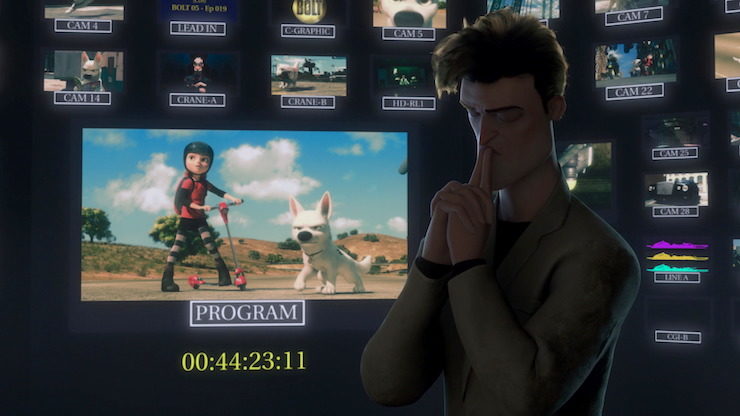
This setup has a number of problems, including the biggest: I can’t buy the premise, at all. Which may, at this point, sound ridiculous: after all, I’ve accepted that an elephant can fly, that a little alien can find a home after crashing on earth, and that someone as uptight and responsible as Elsa really would just let it go. But I can’t believe that a Hollywood studio would go to this much effort and expense to convince a dog that really, everything he’s surrounded by is real, just so the dog can be a method dog actor. A human, just maybe—cue memories of The Truman Project—but a dog, no.
And from the one clip of the Bolt TV show we get to see, it would also be impossible—Penny and Bolt run from set to set and location to location—that is, from soundstage to soundstage. The film later confirms that, yes, the television show is filmed on various soundstages, on a large studio lot with a water tower depicting Penny and Bolt. So, how exactly does this fit with the making the dog believe that everything is happening is real? Does Bolt think that the spaces between soundstages—shown in the film—are gaps in reality caused by the evil mechanisms of the One Green Eye Dude?
Also, the cats. I live with cats. And while, I’m the first to admit that they are perfectly able to create their own reality—a reality based on the concept that humans can and should produce tuna fish after each and every visit to the kitchen, I’m also the first to admit that cats cannot exactly be trusted to go along with elaborate schemes, unless tuna fish or naps are involved, and perhaps not even then. And yet, the other two cats in the television show, both perfectly aware that this is only a television show, not reality, decide to go along with the deception, rather than ruining it. Of course, this does give them a chance to mock poor Bolt, which they enjoy, but it also seems, I dunno, just not very cat like.
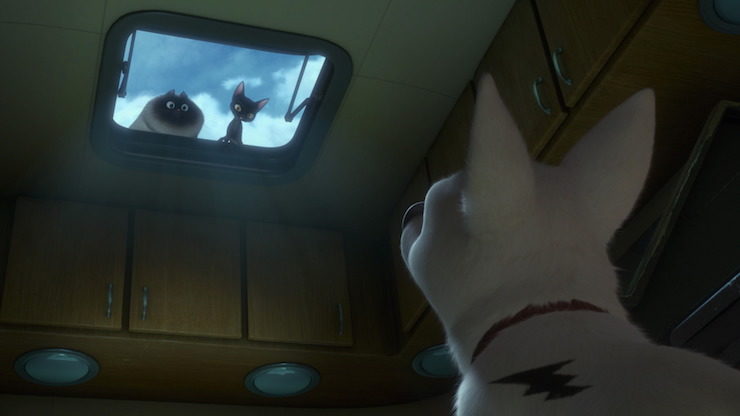
Suspension of disbelief is only one problem. I also found myself more interested in the story I wasn’t getting to see—Bolt and Penny fighting off the one-green-eyed man as he tries to take over the world with only robot minions and two cats. A roadtrip across the United States—even a road trip involving an excitable hamster and an exasperated alleycat—just couldn’t quite compete, and finding out that the Bolt and Penny save the world storyline did get expanded and told in the spin off video game was only small consolation.
Despite this, the roadtrip is the much better part of the film. It starts off entirely by accident, as poor little Bolt finds himself shipped over to New York City, where some clever pigeons who almost, but not quite, recognize him, use his fear about Penny and his suspicion of cats to get rid of Mittens, an alley cat who has been running a Mafia-style protection ring/scam on them. Poor Mittens ends up getting thoroughly punished for this, as she winds up forced to help Bolt try to save Penny—that is, return to Hollywood, a task made all the more difficult thanks to Bolt’s belief that he has superpowers –
—and I’m back to complaining about the setup again, since the superpowers Bolt thinks he has are the exact sort of superpowers that would have been added in later by the effects department, so how did the director/crew convince Bolt that he has a superbark if the effects of this would only have appeared in post-production, long after Bolt had been returned to his trailer?
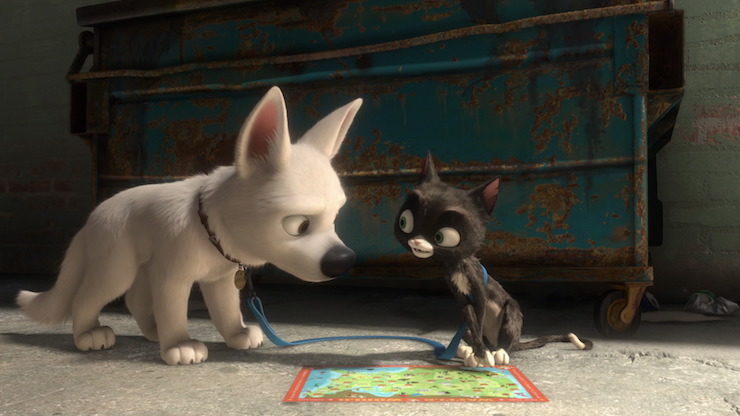
Anyway. Bolt, less skeptical than I am, is convinced that he really does have a superbark, superagility, and superspeed, a belief that Mittens finds both dangerous and terrifying. Not everyone shares her reaction, particularly a little hamster named Rhino, voiced by Disney artist Mark Walton. Rhino, a major fan of Bolt’s television show, has absolutely no doubt that Bolt is a real superhero dog, one capable of rescuing Mittens AND Penny, especially with the help of a hamster.
Meanwhile, back in Hollywood, poor heartbroken Penny has gotten a new dog from the producers, who desperately need the show to go on, Bolt, or no Bolt.
Irritating sidenote: For all of the earlier insistence on how critical and important it was to deceive the original Bolt, no one tries to deceive Bolt II. I smell “We just made up that entire condition in the first part of the film so that we’d have some sort of later plot.” But moving on.
Anyway. Can the REAL Bolt get back to his person Penny, or will he believe Mittens when the alleycat says that humans are disloyal and awful? Will Penny forget about original Bolt and bond with new Bolt? Will Bolt accept the truth about himself—and become a real hero? WILL THE HAMSTER HELP?
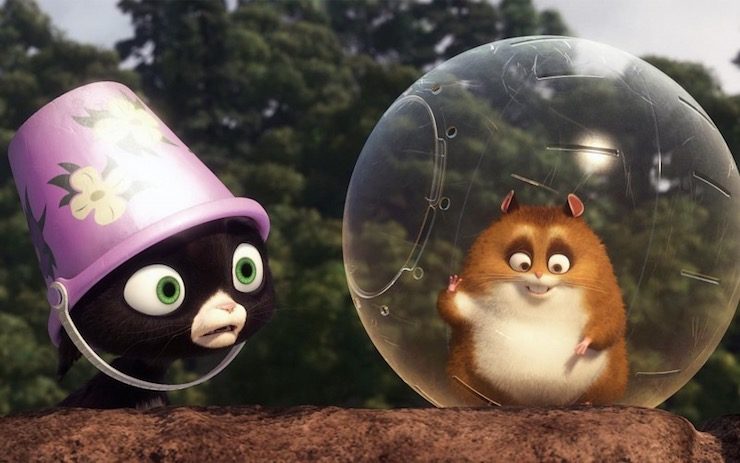
Ok, yes, all of this is incredibly clichéd, but also, incredibly sweet. It’s kinda difficult not to feel a tiny pang when Bolt thinks for a few horrible moments that Penny has forgotten him, after all, or to applaud when Mittens admits that yes, yes, Penny really is Bolt’s person. All together now: AWWWWWWWWWWWWWWWWWWWWW. And Rhino the Hamster is pretty awesome—and able to tell the exact moment when a television show jumps the shark. A hamster action hero who is also an excellent television critic is a rare thing.
And if Bolt’s computer animation hadn’t quite reached the point of creating realistic looking fur—that development would not happen until Zootopia, still a few more films away—the computer animation and character design was a significant improvement over Disney’s previous computer animation work, featuring some frequently gorgeous backgrounds and thrilling camera shots. Bolt, Fake Bolt, and Rhino all often look adorable, and Mittens… ok, Mittens is not adorable, or even attractive, but that’s sort of the point.
I also found myself laughing when two screenwriting pigeons and their brutalized assistant started to pitch ideas at Bolt:
Screenwriting pigeon: We got a nibble!
Other pigeon: Don’t freak out. This is how you blew it with Nemo.
Ok, it’s a terrible joke that won’t age well, but, still, I laughed.
Otherwise, all I could notice was plot hole after plot hole, and several questions about hamsters, and whether or not an alley cat, a dog, and a hamster—however adorable—could really make it all the way from New York City to Hollywood. And quite a few questions about pigeons.
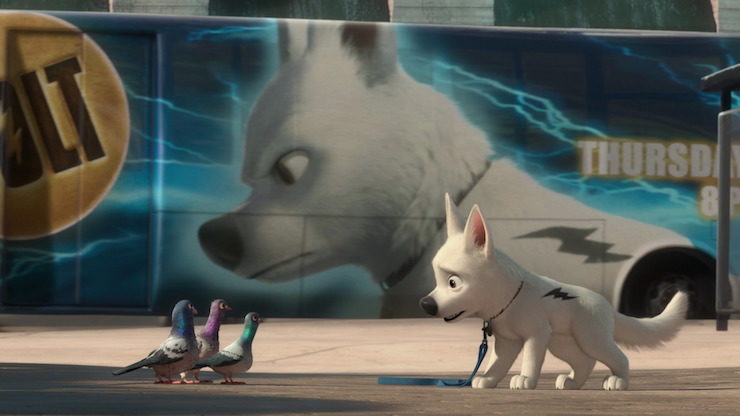
For Disney, however, Bolt was a major relief after a series of critical and box office failures. Bolt received largely warm reviews, and earned $310 million at the box office—well beneath the $550.3 million earned by WALL-E that same year, or the $631.7 million pulled in by Dreamworks’ Kung-Fu Panda, but, still, a respectable sum for an animation studio that had just suffered a series of bombs. The film also spawned a video game, Bolt, which unlike the film focused on Bolt’s more exciting, if fake, TV life, and the usual merchandise of clothing, toys and related projects, and the adorable little plush Bolt is still available in limited quantities in at least one Epcot store. Streaming, DVD and Blu-Ray editions of Bolt remain widely available, and the dog makes occasional appearances in Disney Fine Art pieces.
It was the start of what is now tentatively called the Disney Revival—that is, the period after John Lasseter took over the studio until now, a period that included Disney’s last attempt at a full length hand animated feature (The Princess and the Frog), major hits like Frozen and Zootopia, and the epic story of a video game villain who wants to escape his destiny, Wreck-It-Ralph.
And, oh, another attempt at showcasing what was at the time Disney’s hands down most valuable franchise: Winnie the Pooh, coming up next.
Mari Ness lives in central Florida.










